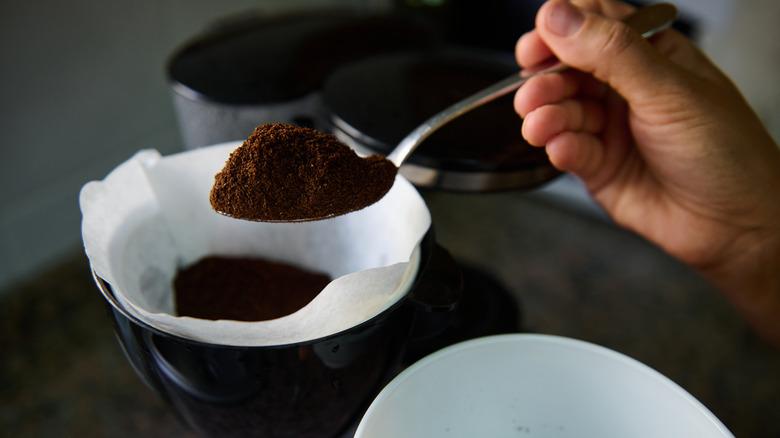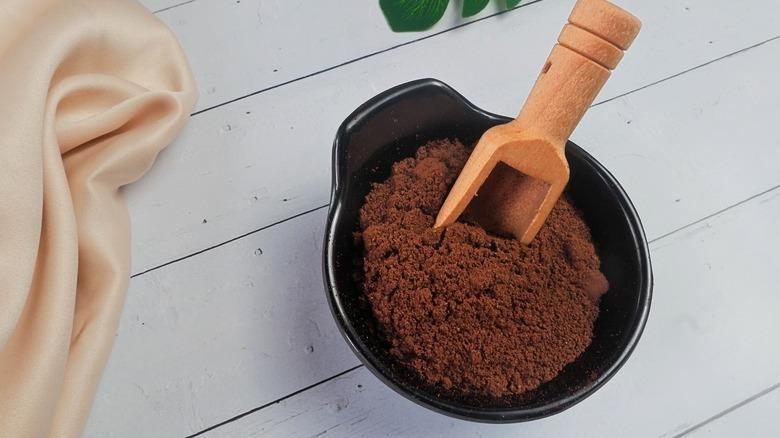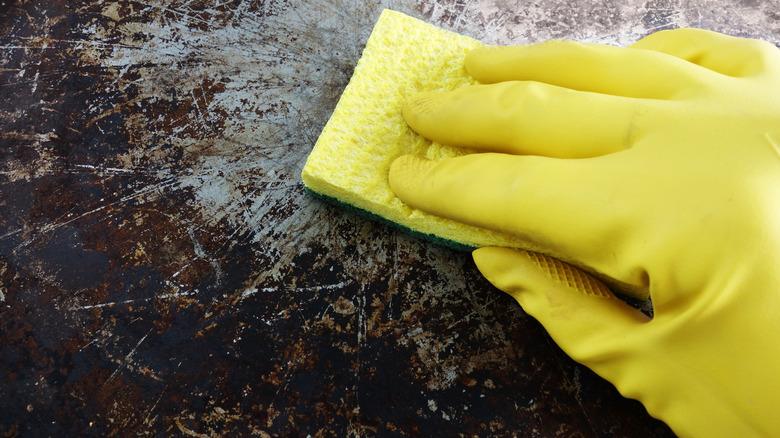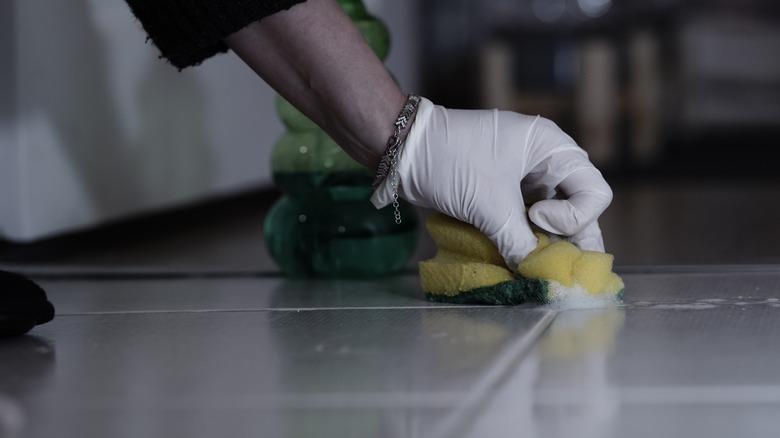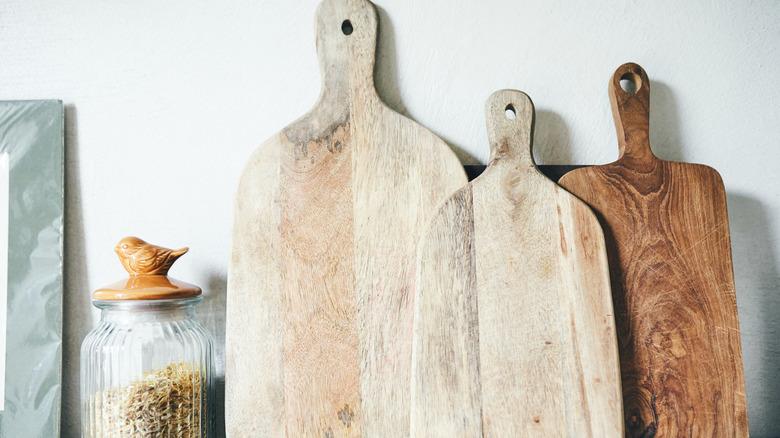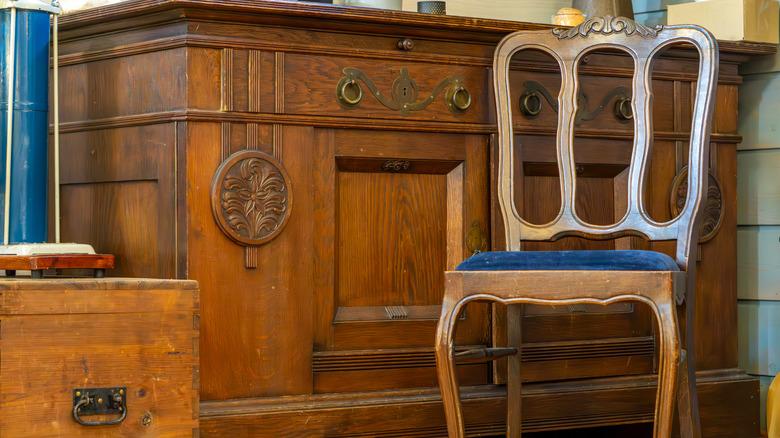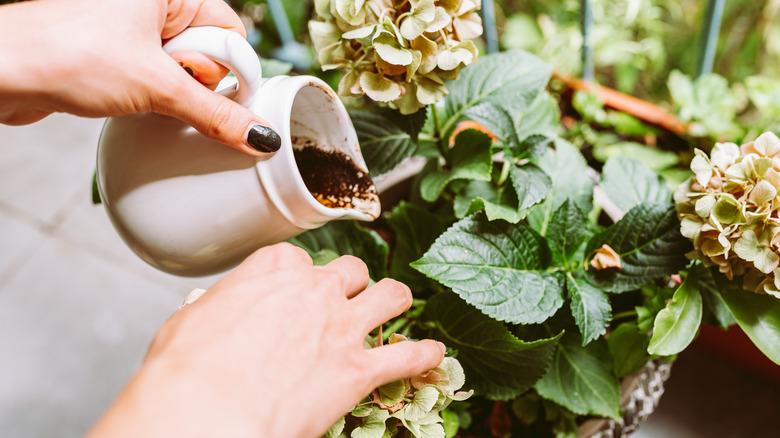Genius Ways To Reuse Old Coffee Grounds In Your Home Instead Of Tossing Them
Brewing coffee is an important part of daily life for many people in the U.S. You might even consider yourself among the 154 million adults who drink coffee on a regular basis, as estimated by The Journal of Nutrition. The daily ritual is among the many reasons you may even be wanting to create an ultimate coffee station in your kitchen. As coffee consumption doesn't appear to be slowing down anytime soon, many people are looking for ways to make their daily ritual more sustainable. You may have, for example, ditched plastic single-use cups for ground coffee. However, even ground coffee can build up in landfills over time and emit harmful methane gasses.
Instead of feeling wasteful each time you dispose of coffee grounds, though, there may be ways you can repurpose brewed coffee grounds into multiple household uses. Not only is this arguably a more environmentally friendly solution, but some of the ways you can reuse old coffee grounds may even help you save money in the long run. Before employing any of these tricks in your home, it's important that all used grounds are completely dry. This will help the grounds be more efficient while also preventing mold.
Deter certain pests from your home's entry points
Everyone has to deal with occasional pests entering their home, especially during the warmer months of the year. If you're wary about using chemicals and are wondering whether it is safe to use pesticides though, the good news is there may be natural methods that can help deter certain pests from entering your home. This includes coffee grounds, which omit a strong odor that may keep certain pests away. Among the pests that purportedly do not like the smell of coffee grounds are flying insects, ants, slugs, and fleas. In particular, slugs are vulnerable to caffeine poisoning, and research has found that these bugs may avoid soil with coffee grounds as they know it poses a threat.
If you have problems with any of the aforementioned types of pests entering your home, you might consider reusing coffee grounds as a potential deterrent. First, place the used coffee grounds inside a small bowl or bag to help prevent any staining on any of your home's surfaces. Then, strategically place these items near entry points to help deter pests from crawling or flying inside. Options can include near your doorways or on your window ledges, and especially any area you've witnessed pest activity. It's important to keep in mind that this strategy is best when combined with a comprehensive pest management plan overall, and it may not be 100% effective alone.
Create coffee ground air fresheners
As a regular coffee drinker, chances are that you enjoy the scent the beans create as they brew. Aside from fresh coffee grounds making your kitchen smell great, you may also be able to use old coffee grounds to help your home smell better. Rather than making your entire home smell like coffee, though, this method works by absorbing odors. These purported benefits are directly tied to the nitrogen content of the coffee grounds, which is said to absorb a variety of bad odors. Using this method can also reduce the need for buying other methods of odor-absorbing products.
To use coffee grounds as air fresheners, pour the used product into small bowls or mason jars. Leave these uncovered or so they can easily absorb odors in the air, or poke holes in the lid of the mason jar if you're going this route. You can then place them where you might need air fresheners in your home. A musty basement, a clothing closet, bathroom, or a utility closet full of smelly shoes are just some of the possible places this method can work. You may even be able to use this strategy in place of a baking soda box for the inside of your fridge as a way to help keep your refrigerator clean. Just be sure not to leave the grounds anywhere a pet or child can get to them. Replace the grounds at least every few weeks by composting the old ones and adding new ones to your containers.
Eliminate trash can odors
While you can use coffee grounds as air fresheners, you may also be able to use them to get rid of odors in more enclosed spaces, too. This includes the stink-prone trash can. While you might have tried to control trash odors with different styles of cans or brands of liners, it can be challenging to eliminate all odors. Kitchen trash cans are especially vulnerable because of bacteria from food waste. It turns out that such spaces are other opportunities for used coffee grounds to lend a hand. Just as the nitrogen content may absorb odors in the air, the coffee grounds can similarly help eliminate trash can odors.
Proponents of placing coffee grounds in trash cans suggest adding a large spoonful of the used materials at the bottom of a new trash bin bag. Ideally, you should do this every time you change the bag out. If you happen to forget though, you may still be able to sprinkle some coffee grounds if there are already a few items in the trash can. If successful, you may find your home smelling fresher over time, and you might use fewer trash bags from less frequent changes, too.
Scrub dirty pots and pans
Aside from their ability to deodorize, coffee grounds are also known for their abrasive qualities. It is this particular feature that might make reused coffee grounds useful for scrubbing certain items in your kitchen. For example, coffee can act as a natural scrubbing agent to remove caked-on foods, grease, and sticky materials from pots and pans. The grounds may be especially helpful for hard-to-clean substances that don't lift during regular cleanings with soap and water.
Before scrubbing your pots and pans with coffee grounds, you will first need to apply warm water and dish soap to the insides of each item you're wanting to deep-clean. Then, add up to 1 tablespoon of used coffee grounds. Gently use a soft dish sponge to scrub the coffee-dish soap mixture along your pots and pans until any debris and build-up is removed. Dispose of the coffee grounds in an eco-friendly way by sprinkling them on your lawn (your grass will thank you for the nitrogen boost!), and then rinse any leftover soapy water, and dry per usual.
Use as an occasional grout cleaner
If you have tile anywhere in your home, you may know the struggles often associated with learning how to clean tile grout. Despite regular cleanings, grout can eventually harbor stains and buildup. Before using harsh chemicals such as bleach, you might consider pantry items for cleaning grout first. Baking soda is one option, but there's also some anecdotal reports of reusing coffee grounds for this purpose, too. It's thought that the coarse texture of the used coffee grounds may work by removing debris and buildup along grout lines.
This method calls for creating a cleaning paste out of coffee grounds and water for hard-to-clean tile grout. After applying the mixture directly to grout lines, it's then recommended that you use a toothbrush to scrub the mixture. An important caveat to consider before using coffee grounds for cleaning grout lines is the risk of staining. As such, it's important to dilute the used grounds with enough water, and to thoroughly rinse the solution off immediately. You can then repeat as necessary, rather than leaving the coffee ground paste on the surface of the grout for too long. If you are concerned about staining a light-colored grout, you can stick to this cleaning method for your non-white grouts only. It's also worth noting that not all users have had success 100% of the time with this solution. If you're willing to try coffee grounds for cleaning tile grout, consider testing one line of grout in an inconspicuous location first.
Freshen up your wooden cutting boards
If you have wooden cutting boards, you know that despite their durability, these need special care to retain their structure while also keeping them sanitary between uses. This also happens to be an area where some people reuse coffee grounds for cleaning. Using coffee grounds may not only remove odors, but they can also act as scrubbing agents to remove stubborn stains. While you will still need to clean your wooden cutting boards with dish soap and hot water, coffee grounds offer a potential opportunity to freshen them up without the use of harmful chemicals that can possibly leach into foods.
Proponents of using coffee grounds on wooden cutting boards suggest first applying dry grounds to a dry board. Then, you can take a damp sponge and work the coffee grounds into any stains or stubborn odors you're wanting to remove. Discard the coffee grounds into a trash can before rinsing your cutting board in a sink. Repeat the process as necessary until your wooden cutting board smells and looks fresher. If you accidentally wash the solution down the drain instead of disposing of them in a composter, you'll need to know how to fix a drain clogged with coffee grounds.
Restore or stain wooden furniture
If you have old wooden furniture that has seen better days, it's possible you might be able to help restore its appearance with the help of coffee grounds. The key is your willingness to experiment with wood staining. First, some proponents suggest you may be able to darken wooden furniture with the natural staining effects of coffee grounds. This works by pouring coffee grounds on top of the wood and letting it sit for an hour to allow the product to take full staining effect. After this time, it's recommended to let the wood dry for several hours before repeating to achieve the desired effect as necessary.
Alternatively, coffee grounds may possibly disguise the appearance of scratches in wood. Proponents of this method recommend making a paste out of old coffee grounds and warm water, and then applying it over the scratched wood. Take a separate towel and gently remove the paste. Just be aware that this strategy will not actually fill in or permanently fix any such scratches. You may also be able to use this method on dark hardwood floors, but it's important to test a small area of flooring first.
Complement fertilizers for indoor plants
You may have heard about gardeners using coffee grounds in their yards, and it's for a good reason. Not only can you potentially grow a thriving green lawn with this natural fertilizer, but it may also benefit certain plants and help control certain diseases, such as root rot. In fact, berries, azaleas, and roses are among some of the outdoor plants that purportedly love coffee grounds the most. It turns out that this coffee ground method isn't exclusive to outdoor plants, though. Used coffee grounds can act as a coffee-based fertilizer for indoor plants, too, as it contains a large amount of potassium, nitrogen, and phosphorus to help plants thrive.
There are two ways you can apply coffee grounds to indoor plants. The first involves sprinkling the grounds around the base of the plant and then combining them into the soil with a small hand rake. If you have more time, you might consider creating your own coffee ground-based liquid fertilizer. This method requires you to combine one cup of used coffee grounds per 2 ½ gallons of water. Allow the mixture to set for a few days and then strain. You can then apply the grounds directly to the plant soil. Experts recommend using this method up to two times per each plant's growing season.
